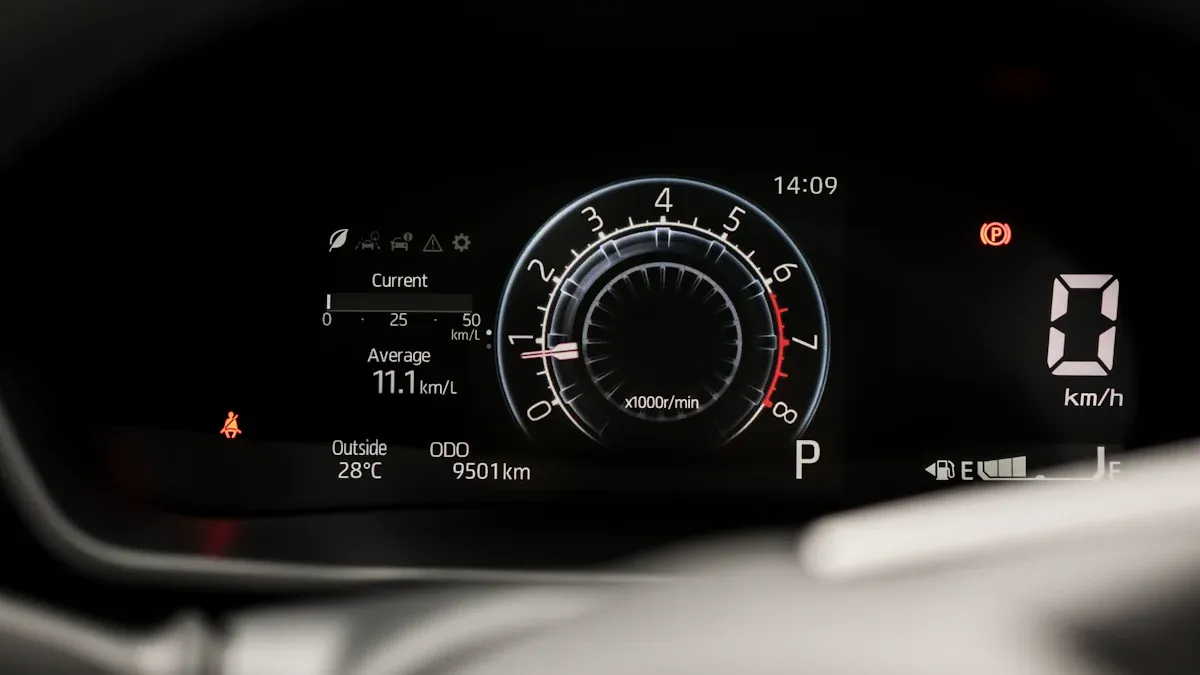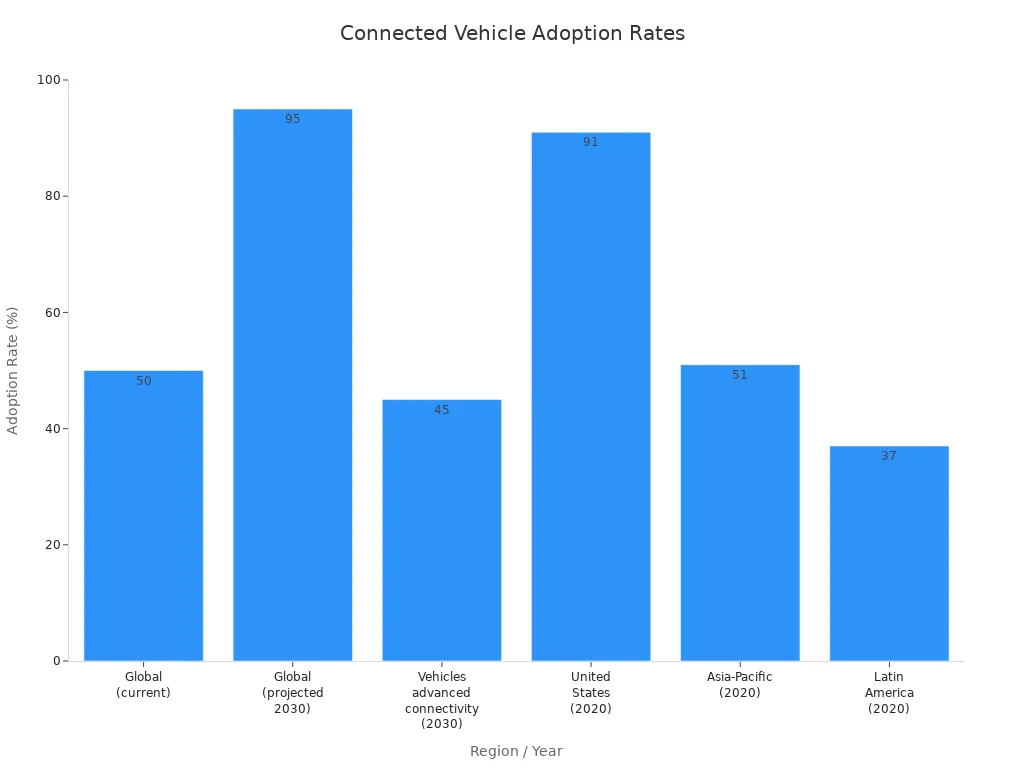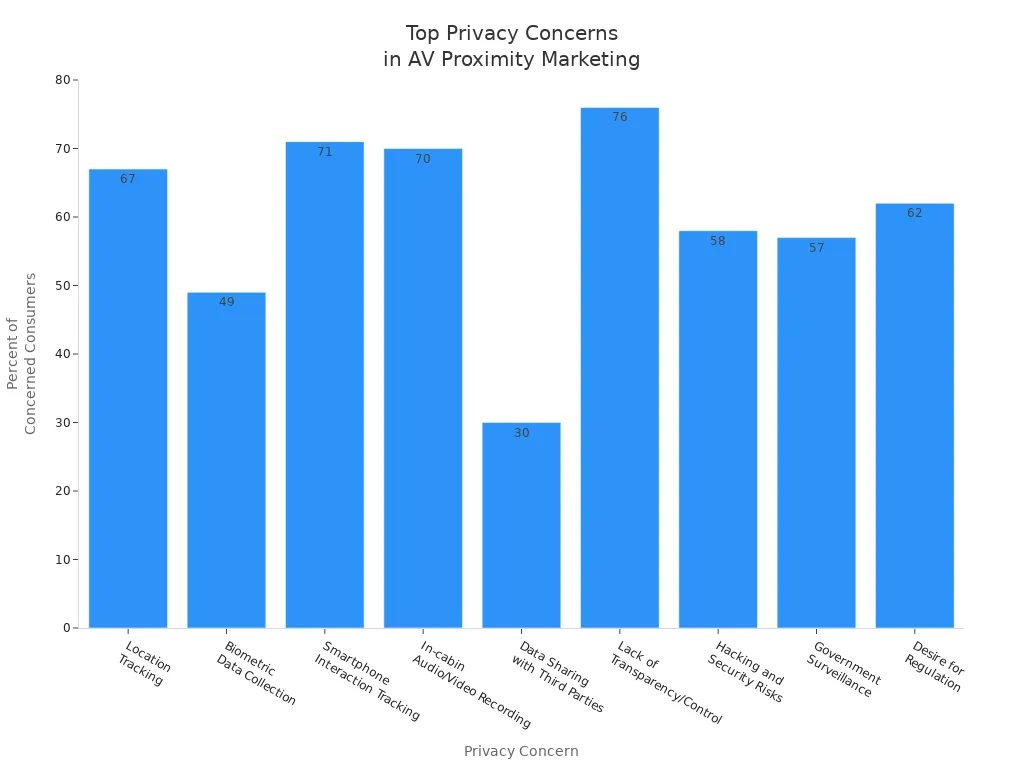
With the rise of 5G and connected vehicle systems, .In-vehicle proximity marketing is evolving rapidly as data sharing becomes faster and more efficient. AI-powered analytics provide valuable insights, allowing you to connect with customers on a deeper level and achieve better marketing results. Immersive experiences, such as AR displays and interactive sensors, enhance .In-vehicle proximity marketing by making interactions more engaging and memorable, which encourages customer loyalty. Sustainability is also shaping .In-vehicle proximity marketing by delivering helpful information and utilizing safe, eco-friendly technology, building greater customer trust. Mobile marketing vehicles like buses and RVs are now used for unique .In-vehicle proximity marketing campaigns that stand out. Today, .In-vehicle proximity marketing delivers personalized and intelligent marketing, helping you foster strong, lasting customer relationships.
Key Takeaways
AI personalization and real-time data show ads for each driver. This helps sell more and makes customers happier.
Connected vehicles use 5G and IoT for location-based ads. These ads make driving safer and marketing better.
Omnichannel strategies use mobile apps, beacons, and push notifications. They reach customers anytime and anywhere.
Immersive experiences like AR displays and voice activation are fun and safe. They help connect with car buyers in new ways.
Strong privacy tools and careful data use build trust. They keep customer information safe and help green campaigns.
Advanced Targeting
AI Personalization
You can now reach people more easily with smart AI tools. AI and machine learning look at customer data, online actions, and what people buy. This helps make ads that talk to each driver and passenger. You get audience targeting that sorts customers by age, buying habits, and how they interact. This way, you send messages and deals that fit each person’s likes and needs.
Car dealerships use AI to find leads that are most likely to buy, so your marketing works better.
AI chatbots talk to customers right away, helping you connect and make sales faster.
Customer Data Platforms let you see everything about each customer, so you can send special messages and suggest cars they might like.
In vehicles, AI makes the ride better by giving content ideas and using voice controls, making things easier for passengers.
Companies like Porsche use AI to suggest car choices that match what each customer likes.
You get real results with this plan. AI personalization in cars brings a 10-20% jump in sales, a 20% rise in customer happiness, and up to 50% more engagement. These numbers show that smart targeting and quick replies help your marketing do better.
Real-Time Data
Real-time data changes your ads from basic to more useful ones. You can use new chances right away, not old info. Automated alerts based on live customer actions tell your team about buyers, so you can reach out fast and answer quickly.
Instant updates show your ads with the newest stock, prices, and deals.
Dynamic ad changes make content fit what customers do and like, so ads work better.
Geo-targeting aims your ads at local buyers who want cars now.
Real-time dashboards help you watch trends and change ads fast, making your ads work best.
With real-time data, you always target the right people. You waste less money on ads and make sure your marketing finds the right customer at the right time. This keeps your ads working well and your audience interested.
Connected Vehicles

IoT & V2X
Cars now connect to many things around them. With 5g, your car acts like a smart device. IoT and V2X let cars talk to other cars and traffic lights. They also connect with city systems. This helps keep you safe and avoid traffic jams. You get quick updates about road dangers and nearby places. This makes your drive easier and safer.
The connected vehicle market was worth USD 21 billion in 2024. Experts think it will grow by 10.8% each year from 2025 to 2034. 5g and V2X help this market grow fast. IoT lets you stream shows, get traffic alerts, and know when your car needs fixing. These features make driving better and help with advertising. You get ads that match where you are and what you need.
Region/Country | Connected Vehicle Adoption Rate |
|---|---|
Global (current) | ~50% of new vehicles connected |
Global (projected 2030) | 95% of new vehicles connected |
Vehicles with intermediate/advanced connectivity (2030) | 45% |
United States (2020) | 91% of new vehicles connected |
Asia-Pacific (2020) | 51% of new vehicles connected |
Latin America (2020) | 37% of new vehicles connected |

5g lets advertisers use geofencing. You get offers based on your exact spot. As more cars use this tech, ads become more personal. You see ads that fit your location and needs.
Infotainment Integration
Modern infotainment systems make location-based marketing real. You use touchscreens, voice helpers, and apps in your car. These systems use 5g for fast and smooth content. You get ads that fit your likes and where you are.
Infotainment systems can be tricky, but new fixes help:
Upgradable systems work with new phones and apps.
Modular platforms make updates and security better.
Hardware lets you use both wired and wireless devices.
Developers use shared rules for good experiences.
Geofencing ads pop up as you get close to certain places. Location-based tech helps brands send ads that feel right for you. With strong security, you trust your data is safe while getting ads that matter to you.
In-Vehicle Proximity Marketing
Omnichannel Strategies
You can make .in-vehicle proximity marketing better with omnichannel strategies. These strategies connect every step, like mobile apps and dealership visits. This makes the customer journey easy and fun. When you use mobile marketing and mobile advertising together, you reach people everywhere. You can reach them online or offline. Proximity marketing tools like beacons, NFC, and push notifications help you send offers at the right time. These offers match where each customer is and what they need.
POS integration lets customers get and use loyalty points online and in stores.
Mobile wallets work as digital loyalty cards, so joining programs and getting rewards is simple.
Proximity marketing gets more people to visit and join with location-based push notifications.
NFC-enabled experiences make it easy for customers to join loyalty programs and interact.
You make things smooth by bringing your marketing and sales teams together. Shared data from CRM systems helps you send special offers and keep your messages the same. This builds trust and loyalty. Customers may even tell others about your brand. If you talk to buyers early, even before they want to buy, you reach more people. This can help you sell more. Giving online buying options meets what people want today and helps you get more sales.
Tip: When you mix proximity marketing with mobile marketing, your offers reach the right person at the right time. This makes your campaigns work better.
Data-Driven Optimization
You make .in-vehicle proximity marketing better by listening to feedback and using real-time data. Get feedback at important times. Look at trends and change your campaigns to fit what customers want. This helps you target better and make stronger offers. Your mobile marketing gets more effective.
Mobile marketing and mobile advertising get better when you keep improving. First-party data gives you clues about what customers like and do. This helps you make location-based marketing and proximity offers that fit each person. When you test and check changes, your campaigns stay new and interesting. You build better relationships and get more loyalty by always changing to meet customer needs.
Immersive Experiences

AR Displays
AR displays change how you see car ads. Augmented Reality and Virtual Reality let you look at cars from anywhere. You can try a virtual test drive or change car features right away. These tools make things safer and more fun. You use digital showrooms and walk through cars on a screen. You see real driving scenes that look almost real. This helps you trust the brand and like it more.
Aspect | Advancement | Impact on User Engagement |
|---|---|---|
Holographic images on windshields (like WayRay, Raythink) | Shows info fast, safer driving, feels real | |
Display Technologies | TFT-LCD, OLED, Micro LED | Brighter screens, clearer pictures, better for users |
Sensor Fusion | Cameras, radars, LiDAR | Gives correct info, AR works well, builds trust |
Marketing Applications | Virtual showrooms, AR customization | Lets you explore, helps sell more cars |
Industry Developments | Bosch, Audi AR HUDs | Easier to use, more comfort for drivers |
Regional Trends | Asia Pacific 3D AR HUDs | More people use it, better experiences |
You get info quickly and talk to brands in new ways. You feel safer and enjoy your ride more.
Voice Activation
Voice activation changes how you use your car. You use your voice to play music, find places, and change the temperature. This keeps your hands on the wheel and your eyes on the road. Voice AI helps answer questions about buying or fixing your car. It also helps in emergencies. You get help fast without touching anything.
Voice helpers like Alexa, Google, and ChatGPT make talking easy.
Smart systems learn how you speak and know many languages.
Updates from the cloud add new things and make it work better.
5G makes your voice commands work right away.
Audi’s ChatGPT lets you ask anything and get good answers.
You can set your own commands to make your car fit you.
Voice activation makes driving safer and easier. You use it more and feel closer to your car and the brand.
Privacy & Security
Consent Management
As in-vehicle proximity marketing grows, new privacy problems appear. Many people worry about how companies use their data. Some are scared about location tracking, biometric data, and in-cabin recordings. The table below shows these worries:
Privacy Concern | Supporting Data / Statistics | Description / Consumer Worries |
|---|---|---|
Location Tracking | 92% of AVs collect location data; 67% worry about sharing | Fear of tracking movements and sharing with third parties. |
Biometric Data Collection | 81% use facial or biometric data; 49% worry about data being sold | Worries about misuse and identity theft. |
Smartphone Interaction Tracking | 71% track smartphone interactions | Concerns about profiling and data misuse. |
In-cabin Audio/Video Recording | 70% collect in-cabin recordings | Worries about constant surveillance. |
Data Sharing with Third Parties | Automakers share data with over 30 companies | Risks of misuse and loss of control. |
Lack of Transparency/Control | 76% want more transparency; 55% want full control | Demand for clear policies and opt-out options. |
Hacking and Security Risks | 58% fear hacking | Worries about cyberattacks and data leaks. |
Government Surveillance | 57% worry about government surveillance | Concerns about unauthorized access. |
Desire for Regulation | 62% support stricter regulations | Demand for stronger legal protections. |

Strong consent management helps fix these worries. New tools have certifications and follow many rules. You can show banners that let users pick what they want. People can change their choices easily. Audit trails and safe data handling help you follow the law. These things lower your risk of fines and keep your good name. Companies like Motional do not sell personal data. They let people opt out and only share with trusted partners. You must follow laws like CCPA and FTC rules. These laws say you need clear consent and strong data safety.
Edge Computing
Edge computing keeps data safe inside the car. This tech lets the car process data right there. You do not have to send private info to the cloud. This lowers the chance of hacking or someone stealing data. Local processing uses less internet and gives you more control. You can use security tools like encryption and authentication in the car. This helps real-time marketing and keeps customer info private. Edge computing also helps you follow new privacy laws. It limits how much data leaves the car. Your customers feel safer and your marketing stays secure.
Sustainability Trends
Green Campaigns
Many car brands now use green campaigns. These campaigns talk about eco-friendly products and good business choices. Lots of people care about the environment. They want to buy from companies that care too. If you pick a car brand with green marketing, you trust them more. You also feel loyal to them. Brands that show real benefits, like recycling or low emissions, connect better with you.
Studies say green campaigns do more than sell things. They help you see the brand as honest and caring. When companies give clear messages, you believe their promises. Social value matters a lot. You might feel proud to drive an electric car. It shows you care about the earth. This feeling can be stronger than saving money.
Tesla is a good example of this.
The company uses new ideas and cool looks to get buyers.
Tesla wants to use renewable energy for its work.
Their ads ask you to pick eco-friendly ways to travel.
These actions help cut greenhouse gases and inspire others.
Tip: When you see green campaigns, check if brands do what they say. You trust them more when they are honest and keep their promises.
Responsible Data
You want car brands to protect your data. This is important when they collect info from your car. Responsible data means companies use your data for good reasons. They keep your info safe and private. If brands use data for green campaigns, they should show how your choices help the earth.
You want to know your data is safe. Brands that explain their rules and let you control your info earn your trust. Good data use helps the planet too. Companies can track how their products affect the earth and share this with you. This helps you choose better and pushes brands to do more for the environment.
Note: Ask brands how they use your data for green goals. Good data rules help you and help the earth.
Proximity marketing helps you connect with customers in cars. Mobile marketing lets you reach buyers when and where it matters. You use real-time data and location info to make marketing better. Customers want smooth and personal experiences. More than half of buyers pick dealerships that give them what they like, even if it costs more. Mobile marketing apps help you keep customers coming back. Buyers book more service visits with these apps. Proximity tools send special offers and help you see how many people visit. Marketing teams now mix online and offline ads. You can sell up to 25% more cars by making buying easier.
Tip: Keep your mobile marketing fresh. Use proximity data and listen to what customers say. You build trust and loyalty by being honest and clear with your marketing.
FAQ
What is in-vehicle proximity marketing?
In-vehicle proximity marketing sends ads to people in cars. It uses location data and special car technology. You get messages at the best time. This makes mobile marketing work better.
How does mobile marketing work in connected vehicles?
Mobile marketing uses apps, sensors, and car screens. It sends messages just for you using real-time data. You get these messages while riding, so you may pay more attention and like the brand more.
Is my data safe with mobile marketing in vehicles?
You can control your data with special tools. Companies use edge computing to keep your info in the car. This keeps your data private and safe. Your information does not have to leave the car.
What are the benefits of mobile marketing for car dealerships?
You get more buyers with offers based on where they are. Instant alerts help you talk to customers fast. Mobile marketing helps you keep customers, sell more cars, and book more service visits.
How can you make mobile marketing campaigns more sustainable?
You can pick green campaigns and use data the right way. Share messages about helping the earth and track how you do it. Mobile marketing helps you talk about electric cars and green choices. This builds trust with people who care about the planet.
See Also
Key Developments Influencing Wireless Adapters For Android Auto
Why You Should Consider AI Box CarPlay In 2025
Budget-Friendly Portable CarPlay Solutions Suitable For All Drivers
Top Five Wireless CarPlay Dongles To Simplify Your Drive
Single Cost-Effective CarPlay Device Compatible With Cars And Bikes
